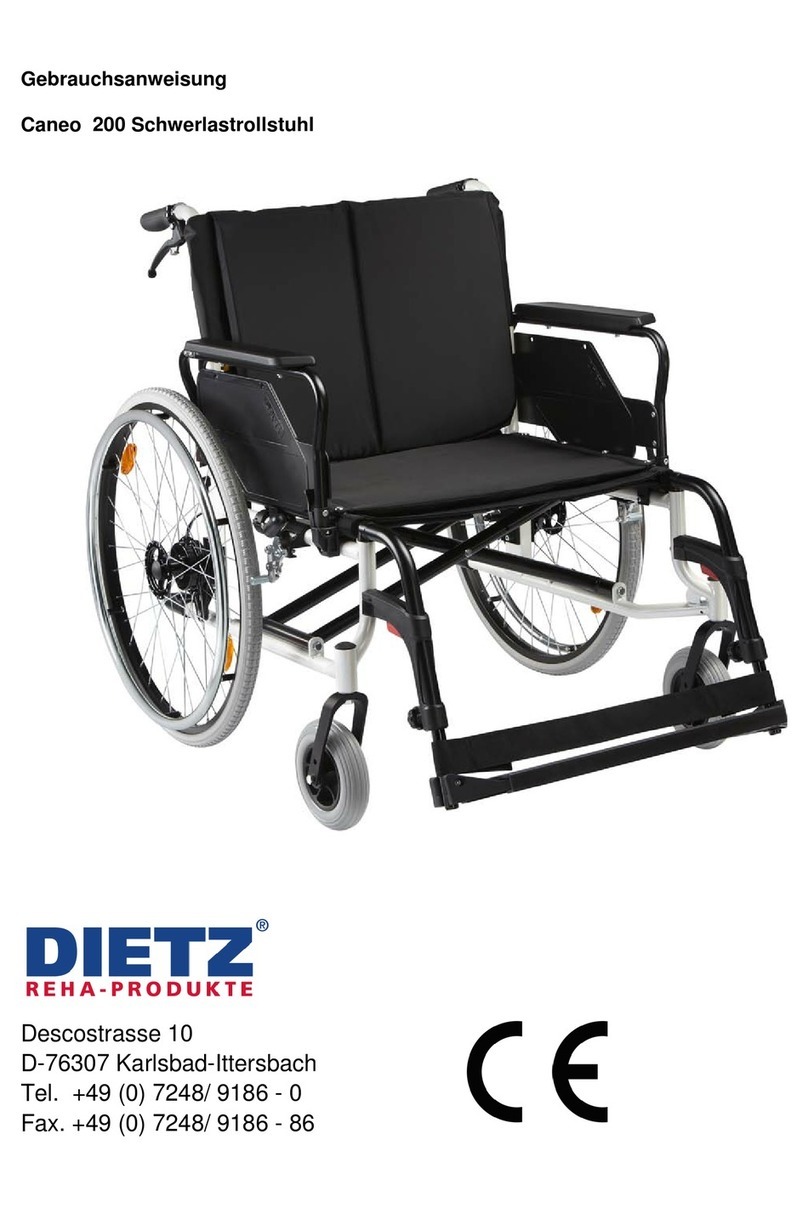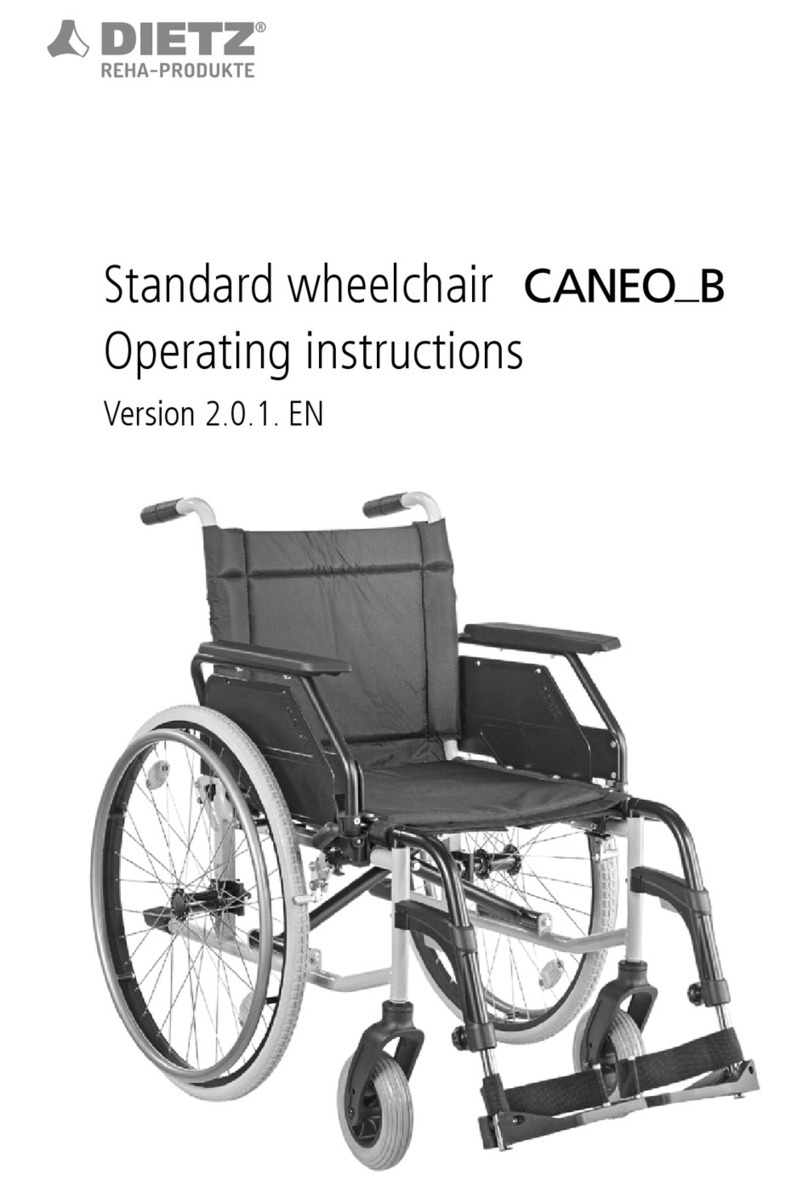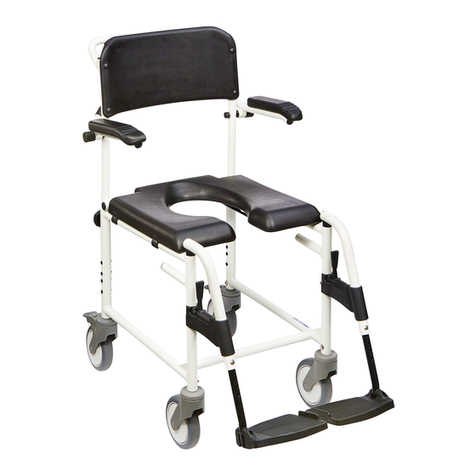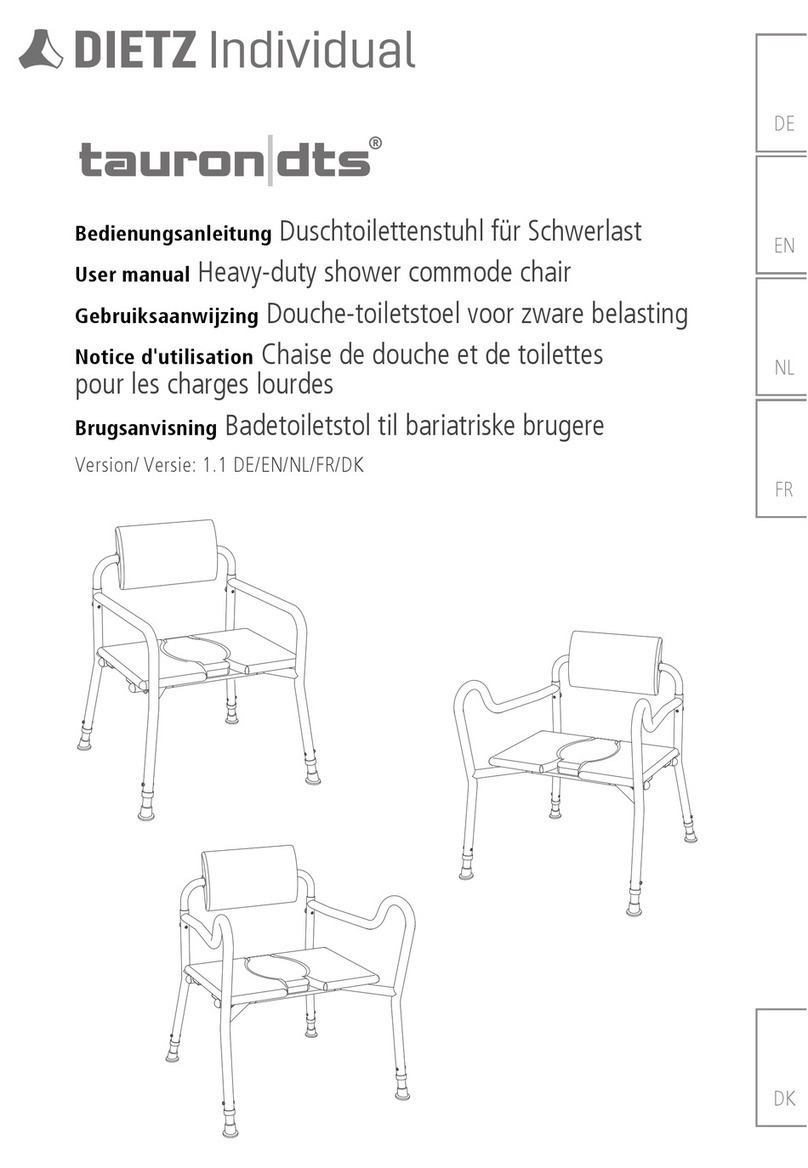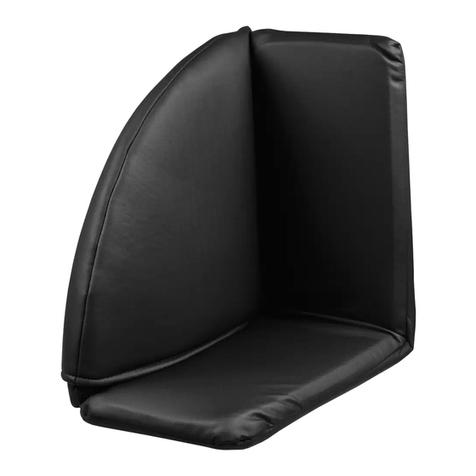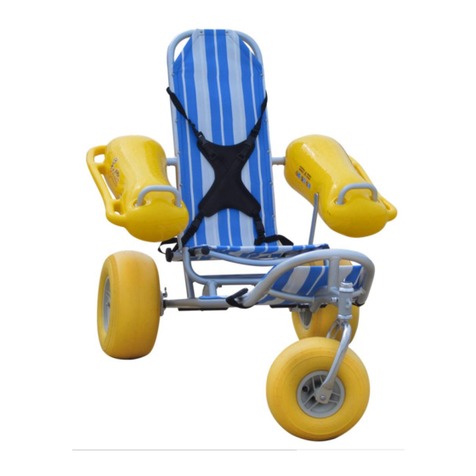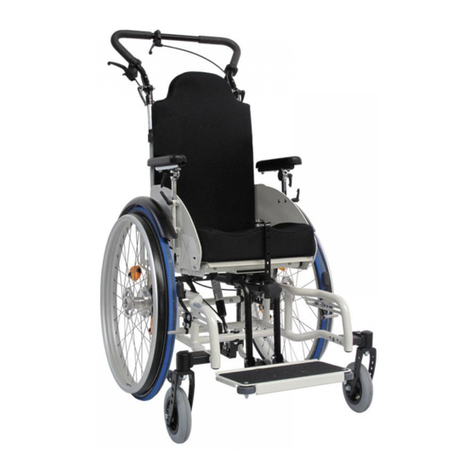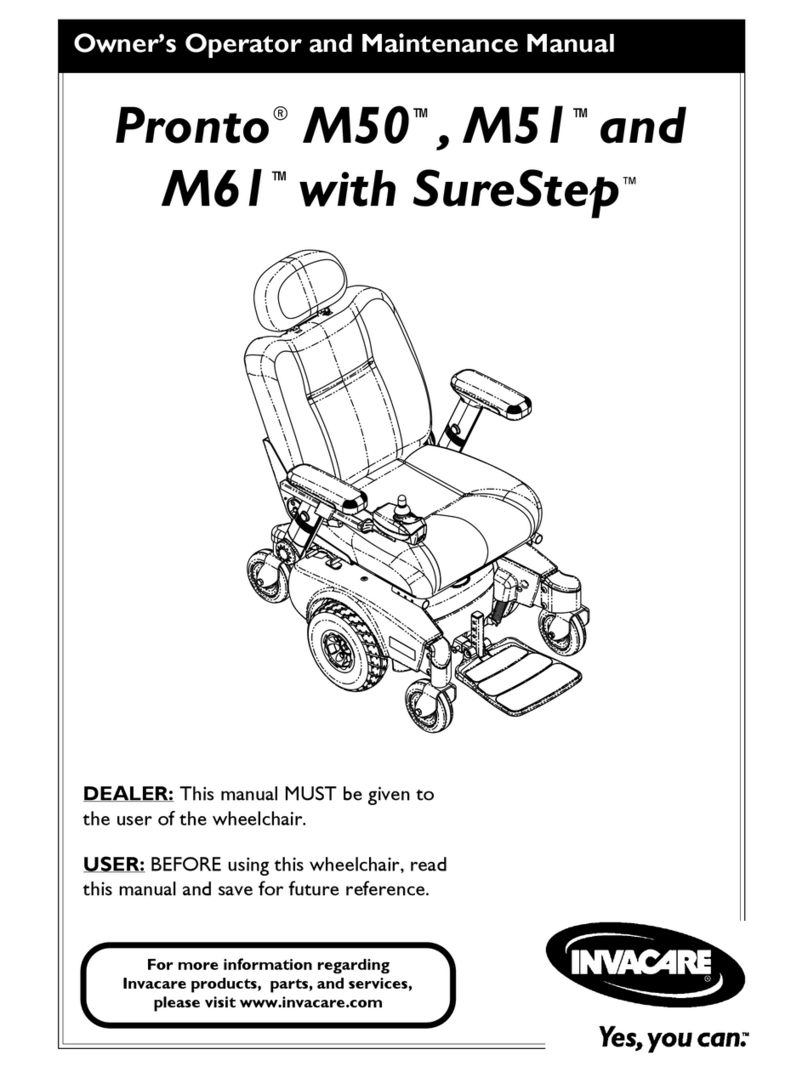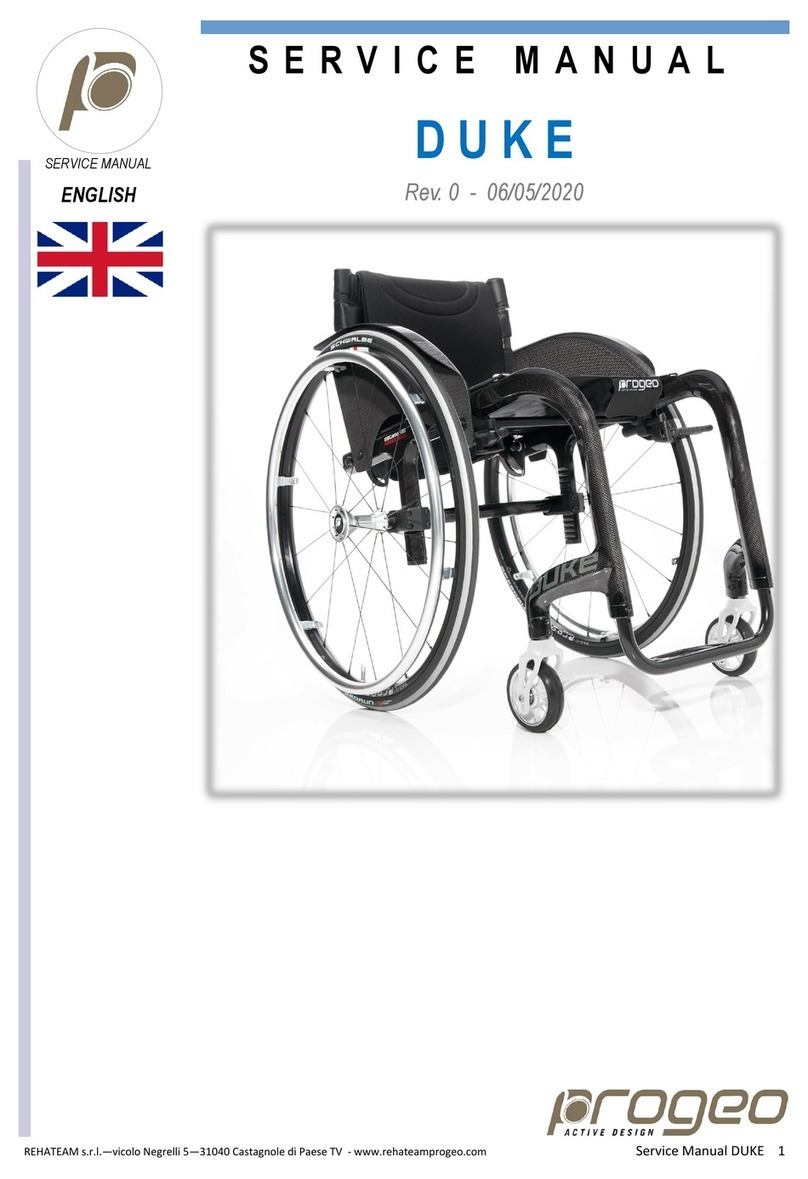Dietz MINKO User manual

USER MANUAL
Power wheelchair
Version 3.0.1 EN

2 - MINKO
© 2021 DIETZ GmbH
All rights reserved
The information provided in this document is not to be reproduced or
disseminated in any way or by any means (electronically or mechanically) without
the prior and express written permission of DIETZ GmbH.
The information provided is based on the general design and construction
specications known to us at the time of publication.
DIETZ GmbH has a policy of continuous product improvement and therefore
reserves the right to make changes without notice.
The information provided applies to congurations of the product that have
been approved by DIETZ. DIETZ GmbH is not liable for loss or damage caused by
components and spare parts from third parties that have not been approved by
DIETZ GmbH.
The information provided has been compiled with the utmost care. However,
DIETZ GmbH is not liable for misprints, content-related errors or their
consequences.
In accordance with trademark protection legislation, the common names, trade
names, brand names, etc. used by DIETZ GmbH are not to be considered as freely
available for use.

MINKO - 3
Table of content
1 Preface ...........................................................................................................................5
1.1. Important information about this user manual 5
1.2. Symbols used in this manual 5
2 Safety..............................................................................................................................6
2.1. Temperature 6
2.2. Moving parts 6
2.3. Electromagnetic radiation 7
2.4. Markings on the wheelchair 7
3 Intended purpose / product description ...................................................................9
3.1. Congurations 9
3.2. The user 9
3.3. Indications 10
3.4. Contraindications 10
3.5. Operating environment 10
4 Preparing the wheelchair for use ................................................................................. 12
4.1. Assembly information 12
4.2. Attaching the joystick 12
4.3. Attaching the backrest (Minko w/ electr. backrest) 12
4.4. Installing the batteries 12
4.5. Controller plug connections 13
4.6. Checking operation in drive mode 13
5 General procedures....................................................................................................14
5.2. Seat cushion 14
5.3. Back cushion 14
5.4. Leg rests 15
5.5. Headrest 15
6
Wheelchair settings (for qualied specialists only) ......................................................16
6.1. Tools 16
6.2. Setting the seat height and tilt angle 16
6.3. Setting the seat depth 17
6.4. Setting the seat width 17
6.5. Setting the backtrest angle 17
6.6. Setting the armrests 17
6.7. Setting the controller and joystick position 19
6.8. Setting the headrest 19
6.9. Cane holder (optional) 19
6.10. Elevating leg rest (optional) 20
6.11. Amputee support (optional) 21
6.12. Lap belt (optional) 21
6.13. Accessories and add-ons from external suppliers 21
USER MANUAL

4 - MINKO
Further manuals are enclosed with the product:
• Manual for the VR2 control unit
• Manual for the battery charger
7 Wheelchair adjustments ............................................................................................22
7.1. Powered adjustments 22
7.2. Mechanical adjustments 23
8 Using the wheelchair .................................................................................................24
8.1. Checking the wheelchair 24
8.2. Getting into and out of the wheelchair 24
8.3. Driving the wheelchair 25
8.4. Driving on slopes or ramps 26
8.5. Obstacles 27
8.6. Pushing the wheelchair 27
8.7. Storage of the wheelchair after use 28
8.8. Immobilizer 28
9 Transport .....................................................................................................................30
9.1. Transporting the wheelchair in motor vehicles 30
9.2. Special transport 31
10 Servicing / maintenance ...........................................................................................32
10.1. Maintenance 32
10.2. Maintenance schedule / inspections 32
10.3. Servicing / maintenance 34
10.4. Cleaning the wheelchair and its upholstery 36
10.5. Batteries 36
10.6. Tyres 37
10.7. Re-use 37
10.8. Lifetime 37
10.9. Disposing of the wheelchair 37
11 Technical specications ............................................................................................38
11.1. Standards and requirements 38
11.2. Specications operating force 38
11.3. Specications product 39
11.4. Specications batteries 40
11.5. Electrical diagrams 40
12 Warranty conditions...................................................................................................41
12.1. Record of product identication data 41
USER MANUAL

1 Preface
1.1. Important information about this user manual
The user manual for this powered wheelchair consists of three separate booklets:
• The general user manual (this booklet)
• The manual for the controller
• The manual for the battery charger
Read through these user manuals carefully before using the wheelchair for the
rst time. The information they contain is essential for the safe use and proper
maintenance (cleaning) of the wheelchair. If any of the manuals are missing on
delivery of your wheelchair, please contact your dealer immediately.
A service manual for qualied specialists is also available.
1.2. Symbols used in this manual
Warning
Follow the instructions given under warnings! Failure to exercise due care in
following these instructions may result in physical injury, damage to the wheelchair
or damage to the environment. Where possible, the warnings are given in the
section that is most relevant.
Section references
A reference to another chapter or section in this manual is given in parentheses
enclosing the phrase ‘see’. Example (see 2) or (see 2.4).
Cross-reference symbol
Where required, this general manual makes reference to the other manuals. This
is done in the following way:
CONTROLLER Please refer to the user manual for the controller.
CHARGER Please refer to the user manual for the battery charger.
SERVICE Please refer to the service manual of the product (qualied specialists
only).
A large-print version of the operating instructions
is available for visually impaired persons at
WWW.DIETZ-GROUP.DE in PDF format.
MINKO - 5
1 Preface

2 Safety
You can always nd the latest information on your product on our homepage. For
information or queries concerning product safety and on recalls, please contact
DIETZ in writing or by telephone. You will nd our contact information on the back
of this user manual.
Warning
Follow the instructions given under warnings! Failure to exercise due care in
following these instructions may result in physical injury, damage to the wheelchair
or damage to the environment.
2.1. Temperature
Warning
• Avoid any physical contact with the motors of the wheelchair at all times. When
the wheelchair is in use, the motors are in constant motion and can reach high
temperatures. Any physical contact with the motors could result in burns. After
use, the motors cool down slowly.
• Ensure that the wheelchair is not exposed to direct sunlight for long periods of
time when not in use. Some parts of the wheelchair (such as the seat, backrest
and armrests) can become hot if exposed to the sun for too long. This may
result in burns or skin sensitisation.
2.2. Moving parts
Warning
Wheelchairs contain moving and rotating parts ( gure 1). Contact with moving
parts may result in serious physical injury or damage to the wheelchair. You should
avoid any contact with the moving parts of
the wheelchair.
A. Wheels (turning and pivoting)
B. Swing-away controller arm
C. Powered backrest adjustment
D. Powered tilt adjustment
E. Powered leg rests
6 - MINKO
E
1
2 Safety

2.3. Electromagnetic radiation
The standard version of your powered wheelchair has been tested for compliance
with the applicable requirements relating to electromagnetic radiation (EMC
requirements).
Warning
Despite testing, the following cannot be ruled out:
• electromagnetic radiation interfering with the wheelchair. For example mobile
telephones, large medical devices or other sources of electromagnetic radiation
• the powered wheelchair interfering with electromagnetic elds. For example
shop doors, burglar alarm systems in shops or garage door openers.
• in some congurations equipped with a R-net controller, where it is possible
that extreme electrical discharge situations due to static electricity, may cause
a fault message (‘ISM over-current’) ashing on the screen. If this occurs simply
turn o your wheelchair for a few seconds and back on to clear the fault.
In the unlikely event of such problems arising, please notify your dealer
immediately.
2.4. Markings on the wheelchair
Warning
• The markings, symbols and instructions on the wheelchair are part of the safety
features. They must not be covered up or removed. They must remain on the
wheelchair and be clearly legible for the whole lifespan of the wheelchair.
• Immediately replace or repair any markings, symbols or instructions that
become damaged or illegible. Contact your dealer in such cases.
MINKO - 7
2 Safety

Symbols used on the wheelchair:
Consult the manual before use.
Freewheel switch
• Drive position
• Push position
Warning
Never set the freewheel switch
to the 'Push' position when the
wheelchair is on a slope.
Warning (yellow-black)
Pinch point hazard: Keep hands
and ngers away from moving
parts when adjusting the height
and/or tilt angle of the wheelchair.
Securing point for transportation
inside a vehicle.
Crash-test-certi ed in line with
ISO 7176-19
CONTROLLER
Battery charging point.
Location Identi cation plate:
on the left side of the chassis in
driving direction.
For custom models, which
were customer made for a
particular user, the product label,
intended purpose and warnings
are di erent. Please pay
attention to the additional
documentation!
Identi cation plate
Trademark
Type / model
REF = Item number
UDI = Unique device identifer
(01) UDI-DI
(10) Order number
(21) Serial number
Manufacturer / contact address
Maximum load capacity / user
weight
Date of manufacture YYYY-MM
Maximum speed
6˚ Maximum safe gradient that can
be driven on with the wheelchair*
Follow the user manual
Caution- safety information can be
fount in the user manual
Medical device
Separate disposal of electronic
equipment and components
*depends on the wheelchair settings and user's abilities
xxxx-xx
(01)04260241689952
(10)190XXXX
(21)M90000XXXX
*200059*
630001
Minko
136 kg
6°
6 km/h
8 - MINKO
2 Safety

3 Intended purpose / product
description
Rear wheel drive wheelchairs and their
major components (gure 2)
A. Drive wheels
B. Castor wheels
C. Freewheel switch
D. Controller
E. Battery
F. Seat cushion
G. Backrest
H. Armrest
I. Leg rest
J. Headrest (optional)
3.1. Congurations
Broadly speaking, the wheelchair is made up of an undercarriage with the seating
system on top of it for excellent support for the head, torso, arms and legs.
The wheelchair is available as a rear-wheel drive (RWD) with a speed of 6 km/h.
Warning
• No changes may be made to the technical specications.
• Do not make any adjustments to the electrical circuit.
• Modication of the wheelchair or its component parts is not permitted.
3.2. The user
Driving a powered wheelchair requires the user to have cognitive, physical and
visual abilities. The user must be capable of estimating the consequences of any
action taken while driving the wheelchair and of correcting action where required.
The wheelchair must not carry more than one person. The maximum user
weight is 136 kg, unless otherwise stated on the identication plate (see 2.4). Any
additional weight in the form of a bag, accessories or medical equipment must
be added to the user's weight, with the resulting total weight not exceeding the
maximum user weight.
The user must also be aware of the contents of this manual before using the
wheelchair for the rst time. The wheelchair user must also have received
thorough instruction from the dealer before using public roads. A trainer/
consultant must supervise the user's rst experience of driving the wheelchair.
The intended purpose may dier for products which were manufactured
as custom-made device and which have been labelled as such. In this
case, please refer to the documentation supplied with the product.
MINKO - 9
A
G
J
D
I
H
F
C
B
E
2
3 Intended purpose / product description

Warning
• The wheelchair user shall at all times be fully responsible for compliance with
locally applicable safety regulations and guidelines.
• You must not drive the wheelchair while under the inuence of any substances
that may aect your driving ability.
• Your eyesight must be good enough to allow you to use the wheelchair in any
particular situation safely.
• Do not seat more than one person in the wheelchair.
• Do not allow children to drive the wheelchair without supervision.
3.3. Indications
This wheelchair provides assistance for persons who are unable to walk or who
have a severe walking impediment due to
• Paralysis
• Loss of limbs / defect or deformation of limbs
• Joint contracture/joint damage
3.4. Contraindications
Use of the wheelchair is unsuitable in the case of:
• False sensations
• Severe disequilibrium
• Loss of limbs on both arms
• Joint contracture/joint damage on both arms
• Inability to sit
• Impaired or inadequate vision
3.5. Operating environment
This wheelchair has been developed for both indoor and outdoor use (EN 12184
(2014) class B). When outdoors, drive only on paved roads, pavements, footpaths
and cycle paths. Always adjust your speed to your surroundings.
Warning
• A wheelchair should be regarded as a replacement for the walking function.
Users must therefore travel among pedestrians and not on streets with trac.
• The use of the wheelchair on walk ways and roads may be subject to the
applicable legal requirements of National Road Laws or Road Trac Laws.
• Drive carefully on roads that are slippery due to rain, ice or snow!
• Prevent the wheelchair from coming into contact with seawater, as it is
aggressive and has a corrosive eect.
10 - MINKO
3 Intended purpose / product description

• Prevent the wheelchair from coming into contact with sand. Sand can get into
the moving parts of the wheelchair, causing unnecessarily rapid wear.
• When visibility is limited, the use of lights is compulsory.
• Exercise additional care when driving at high speeds. Adjust to a lower
maximum speed when driving indoors, on pavements and in pedestrianised
areas.
• Do not drive o of high obstacles.
• The wheelchair is tested in accordance with ISO 7176-9 to the ambient
temperatures of -25 °C up to +50 °C. This range of temperature must be
maintained. DIETZ recommends not to use the wheelchair at temperatures
below -10˚C, because te battery power decreases at very low temperatures.
• Do not attach any weights to the wheelchair without consulting a specialist. You
may otherwise inuence the stability of the product.
• Do not use the wheelchair to push and/or pull any objects along.
• Do not open doors using the leg rests.
• Do not drive through puddles of water.
MINKO - 11
3 Intended purpose / product description

4 Preparing the wheelchair for use
4.1. Assembly information
On delivery, the wheelchair is not yet ready to be operated via the controller, as
the circuit still needs to be connected.
So that the wheelchair can be pushed before the batteries are installed, you must
disengage the individual motors and put them into Push mode by setting the lever
to the horizontal position (see 8.6).
4.2. Attaching the joystick
To make it easier for us to transport the wheelchair, the joystick is not attached
on delivery. Attach the joystick to the holder using the screws you will nd on the
bottom of the joystick.
4.3. Attaching the backrest
(Minko w/ electr. backrest)
Screw the backrest actuator to the upper
backrest frame.
1. To do this, remove the upper screw
from the side of the actuator (A, Fig. 3).
2. Fold the backrest backwards until it
surrounds the end of the actuator.
3. Use the screw that you removed
previously to connect the actuator and
backrest frame (A), securing it with the
lock nut supplied inside the box. For
details of the Minko version without
actuator, see section 6.5.
4.4. Installing the batteries
The battery drawer is located between the
two driven wheels at the rear, where it is
secured with a screw. Release the screw
(A) and pull out the battery drawer (B)
(Fig. 4).
The batteries must be connected in series
using the enclosed fuse kit (see Fig. 7,
SERVICE)
The batteries must be secured to prevent
them from slipping. In the case of small
batteries, use the plastic blocks supplied
inside the battery box to wedge them in
place. Finally, pull the battery strap tight.
12 - MINKO
A
B
AA
3
4
4 Preparing the wheelchair for use

4.5. Controller plug connections
Note: Only required if the batteries have
been pre-installed.
On delivery, the controller power supply is
disconnected in the interest of wheelchair
safety. This must be reconnected before
the wheelchair can be driven.
4. To gain access to the controller, you
must remove the cover. To do this,
press down on the middle of the top
edge (A, Fig. 5) to release the cover
locking bolt.
5. You will then be able to fold the cover
forward and down to remove it (B Fig.
5). On the model with electric seat tilt,
you must rst detach the two seat
supports from the chassis using the
4 screws. This allows you to fold back
the seat together with the actuator
(Fig. 6)
6. Check that all plug connections on the
controller are tight and secure (J, A, B,
A, Fig. 7).
7. Reattach the controller cover.
Warning! Make sure that none of
the cables get trapped or severely
kinked (bent by >120°) when attaching
the controller cover.
Hook the bottom of the cover into the
slots, fold it up, place your hands at
the top of the cover and press down
in the middle so that the cover bolt
engages in the wheelchair frame
(A Fig. 5).
4.6. Checking operation in
drive mode
The wheelchair is now ready for use. Switch
the motors to Drive mode (by moving the
lever out of the horizontal position, see
section 8.6). Then, after switching on the
wheelchair with the joystick, please check
that the wheelchair is functioning correctly.
1
5
2
A
B
70A
6Nm
M6
MOT1
MOT2BATT
A A
B
C
C
JSM
J
6
MINKO - 13
7
4 Preparing the wheelchair for use

5 General
procedures
Some parts can be removed/adjusted
without the use of tools. The wheelchair
can easily be reduced in size. For example
to transport the wheelchair (see 9).
Warning!
The removal of parts might have adverse
or benefi cial eff ects on the wheelchair.
5.2. Seat cushion
To remove
Pull the seat cushion (A fi gure 8) upwards.
To replace
Place the seat cushion on the chair.
Warning
• Check the position of the cloth strap
underneath the backrest. It should
stick evenly and loosely to the Velcro
strip on the seat and close the gap
between the backrest and the seat.
• Ensure that the zip on the cushion is at
the back/underneath.
5.3. Back cushion
To remove
1. Remove the fabric (A fi gure 9) from the back straps.
2. Loosen the individual Velcro straps (B).
To replace
1. Pull the Velcro straps in the desired position. Start with the lowest strap.
2. Fold the fabric back over the straps and secure it with the Velcro.
14 - MINKO
1
2
A
B
1
A
9
8
5 General procedures

5.4. Leg rests
To remove
1. Press the handle (A fi gure 10) upwards
to release the leg rest.
2. Swing the legrest (B) to the side.
3. Remove the leg rest by lifting it out of
the bracket.
To replace
Place the leg rest in the bracket in reverse
order.
Warning
• The leg rest is not locked into place
until you hear a click.
• Removing the leg rest may aff ect the
stability of the wheelchair.
5.5. Headrest
To remove
1. Loosen the lever (A fi gure 11) by half
a turn.
2. Remove the headrest (B).
To replace
1. Place the headrest in the desired
position.
2. Lock the headrest in place by
tightening the lever.
MINKO - 15
1
2
A
B
1
3
A
B
2
11
10
5 General procedures

6
Wheelchair settings
(for qualifi ed specialists only)
There is no such thing as the average wheelchair user. For this reason, DIETZ
Power wheelchairs can be adjusted to suit the speci c requirements and
preferences of the individual user. With this in mind, we draw a distinction
between wheelchair adjustment options and wheelchair settings.
• The adjustment options can be con gured by the user without the need for
tools.
• By contrast, the settings are a one-off operation and are – unless otherwise
speci ed – only to be made by quali ed specialists.
Warning
The sections below describe some of the settings. These settings should only be
made by quali ed specialists or by specialist retailers. See
SERVICE for further information about the settings and assembly procedure.
6.1. Tools
Tools required for the settings described
in this section:
• Spanner; 13 mm
• Allen keys; 4, 5 and 6 mm
6.2. Setting the seat height and
tilt angle
The seat height and tilt angle (Figs. 12
and 13) can be set in accordance with the
wheelchair user’s requirements.
All three seat heights (425, 450 and 475 mm)
have been designed not to exceed the
maximum safe slope of 6˚ (10.5%)
according to EN 12184 (2014) Class B.
Lowering the seat height has a positive
impact on the (dynamic) stability.
The settings can be made using the series
of holes labelled A/B and D (Fig. 13). For
further details, please refer to the
SERVICE manual.
Warning
Increasing the seat height changes the
centre of gravity. This has a negative
impact on the (dynamic) stability.
ABD
13
12
6 Wheelchair settings (for quali ed specialists only)
16 - MINKO

6.3. Setting the seat depth
1. Remove the Allen screws (A) (Fig. 14).
2. Move the seat system (B) into the
desired position (B).
3. Reinsert the Allen screws in the new
position and tighten them.
Warning
Altering the seat depth also aff ects the
centre of gravity. This has an impact on
both the general and dynamic stability.
6.4. Setting the seat width
The seat width can be set by altering the
armrest width (see section 6.6).
6.5. Setting the backtrest angle
1. Pull the strap (A, Fig. 15) to release the
locking bolts.
2. Move the backrest into the desired
position (B).
3. Loosen the strap to relock.
Warning
To ensure that the backrest is properly
locked, you must be able to hear the
locking bolts engage with an audible click.
6.6. Setting the armrests
Armrest width (also aff ects the seat
width)
1. Loosen the Allen screw (A) by two
turns (Fig. 16).
2. Move the armrest outwards (B).
3. Fully tighten the Allen screw.
1
2
B
A
16
1
3
2
A
B
1
2
A
B
14
15
6 Wheelchair settings (for quali ed specialists only)
MINKO - 17

Armrest height (200–300 mm)
1. Loosen the screw by one turn
(A, Fig. 17).
2. Move the armrest (B) into the desired
position, up to a maximum of 300 mm.
3. Fully tighten the screw.
Warning
Make sure that the user’s arms are well
supported but that their shoulders are
not being forced upwards.
Armrest pad depth
1. Loosen the two Allen screws (A, Fig. 18).
2. Move the armrest pad (B) into the
desired position (B).
3. Fully tighten the Allen screws.
Clothing protector depth and height
1. Loosen the Allen screws (A, Fig. 19).
2. Alter the depth of the clothing
protector (B) by making use of the
other holes that are available.
3. Alter the height of the clothing
protector by sliding it up or down into
the desired position.
4. Fully tighten the Allen screws.
1
1
2A
B
1
2
B
A
18
17
1
2
3
B
A
19
6 Wheelchair settings (for quali ed specialists only)
18 - MINKO

6.7. Setting the controller and
joystick position
Warning
If the controller parameters are set
incorrectly, it can result in some extremely
dangerous situations. These settings are
only to be made by quali ed specialists..
Joystick depth (option)
1. Loosen the wing screw (A, Fig. 20).
2. Slide the controller (B) into the desired
position.
3. Fully tighten the wing screw.
6.8. Setting the headrest
Headrest height and position
1. Loosen the four wing screws (A, Fig.
21).
2. Move the headrest (B) into the correct
position.
3. Fully tighten the wing screws.
6.9. Cane holder (optional)
1. This is attached to the wheelchair by
mounting it on the seat side frame
element.
2. Screw the cane holder into the holes
provided on the frame for this purpose
using the screws supplied (Fig. 22).
3. In the case of the Minko version
with electric seat, you must use the
mounting plate included with that
version (Fig. 22).
1
2
A
B
1
2
A
B
20
21
22
6 Wheelchair settings (for quali ed specialists only)
MINKO - 19

6.10. Elevating leg rest (optional)
The angle of the elevating leg rest can be
adjusted within the range of 112° to 189°.
Setting/swivelling the leg rest:
1. Insert the leg rest into the holder
at the side from above and swivel it
forwards until it engages.
2. To swivel the leg rest away, press the
push button locking lever (2, Fig. 23)
forwards.
Setting the leg rest length:
1. Loosen the Allen screw (3, Fig. 23) by
one or two turns. The footplate tube is
now free and can be slid upwards or
downwards.
2. Finally, tighten the screw rmly again.
Positioning the calf pads:
1. Loosen the two Allen screws in the calf
pad holder (4, Fig. 23).
2. When you have found the correct
height (4 holes), tighten the screws so
that they are hand-tight.
3. Loosen the Allen screw (5, Fig.23) to
enable depth adjustment.
4. When you have found the desired
depth, retighten the screw so that it is
hand-tight.
Setting the footplate angle:
1. To adjust the angle, loosen the Allen
screw (6, Fig. 23) and pull the footplate
slightly inwards until the lock is released.
2. Now set the footplate to the desired angle.
3. To lock it in place, tighten the screw rmly again.
Adjusting the angle between 112° and 189°:
1. To do this, loosen the locking screw until the screw head can be pulled out
easily (1, Fig. 24) and the lock is released.
2. Now you can set the leg rest to the desired angle (2, Fig. 24.)
3. When you have found the desired angle, release the screw head over the
desired position hole to allow the screw to engage.
4. Finally, retighten the screw so that it is hand-tight (1, Fig. 24).
1
2
2
1
3
4
5
6
24
23
6 Wheelchair settings (for qualied specialists only)
20 - MINKO
Table of contents
Other Dietz Wheelchair manuals
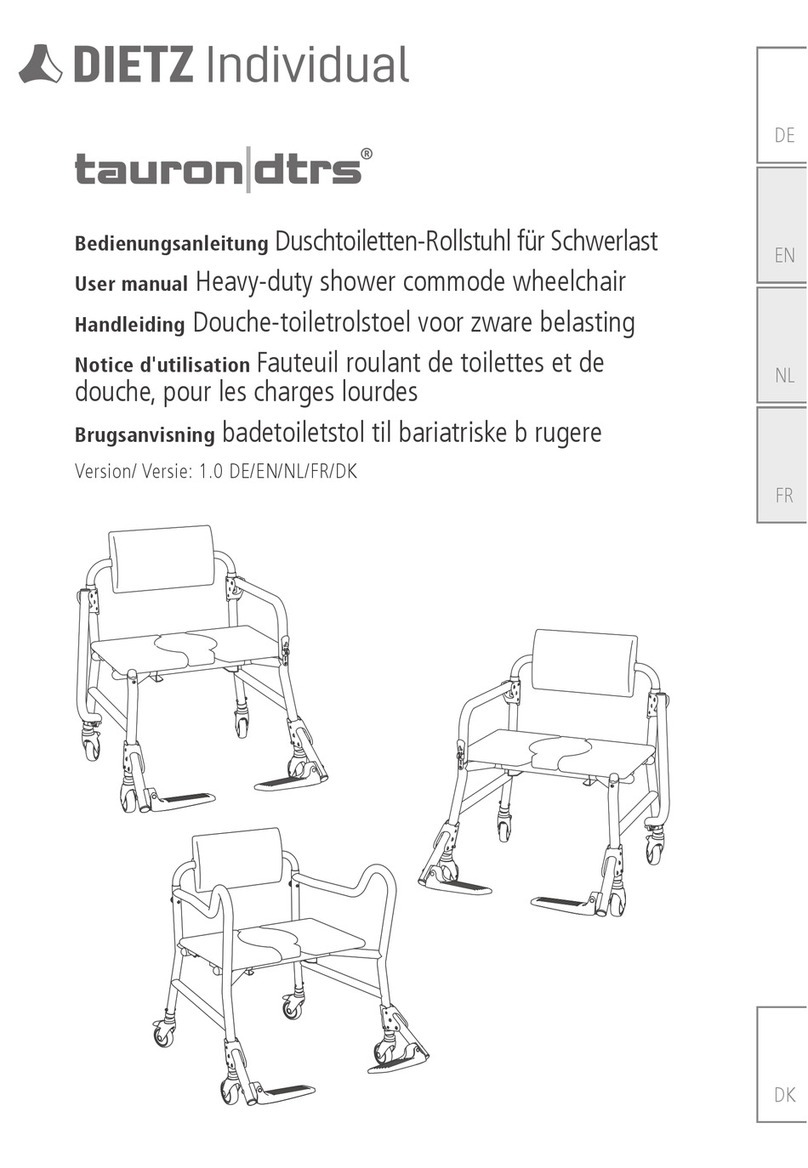
Dietz
Dietz Tauron DTRS User manual
![Dietz AS[01] User manual Dietz AS[01] User manual](/data/manuals/20/j/20jko/sources/dietz-as-01--manual.jpg)
Dietz
Dietz AS[01] User manual
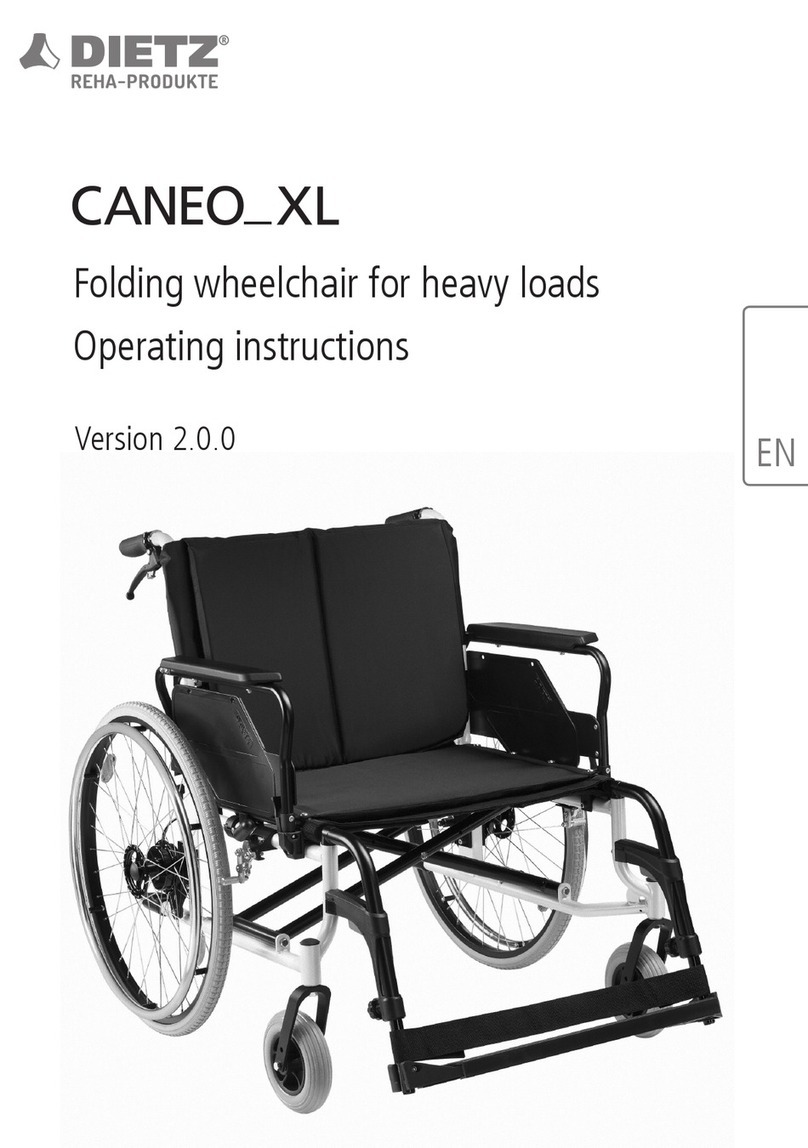
Dietz
Dietz CANEO_XL User manual
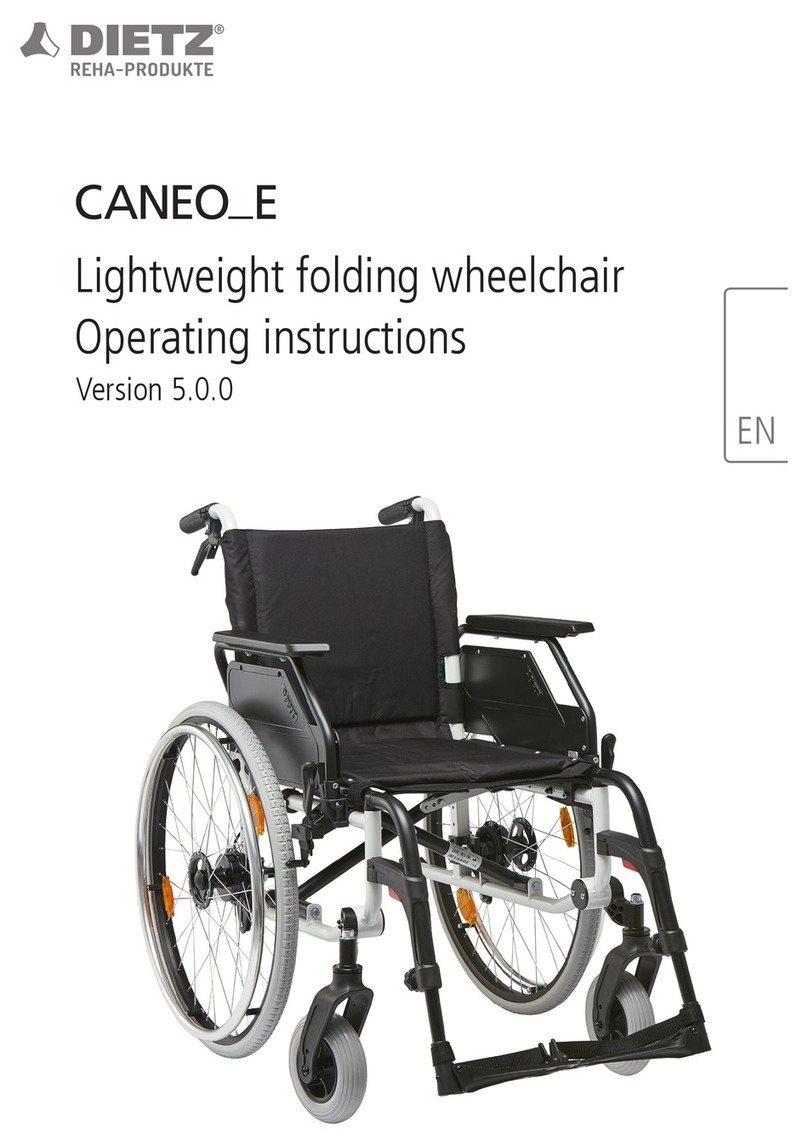
Dietz
Dietz CANEO_E User manual
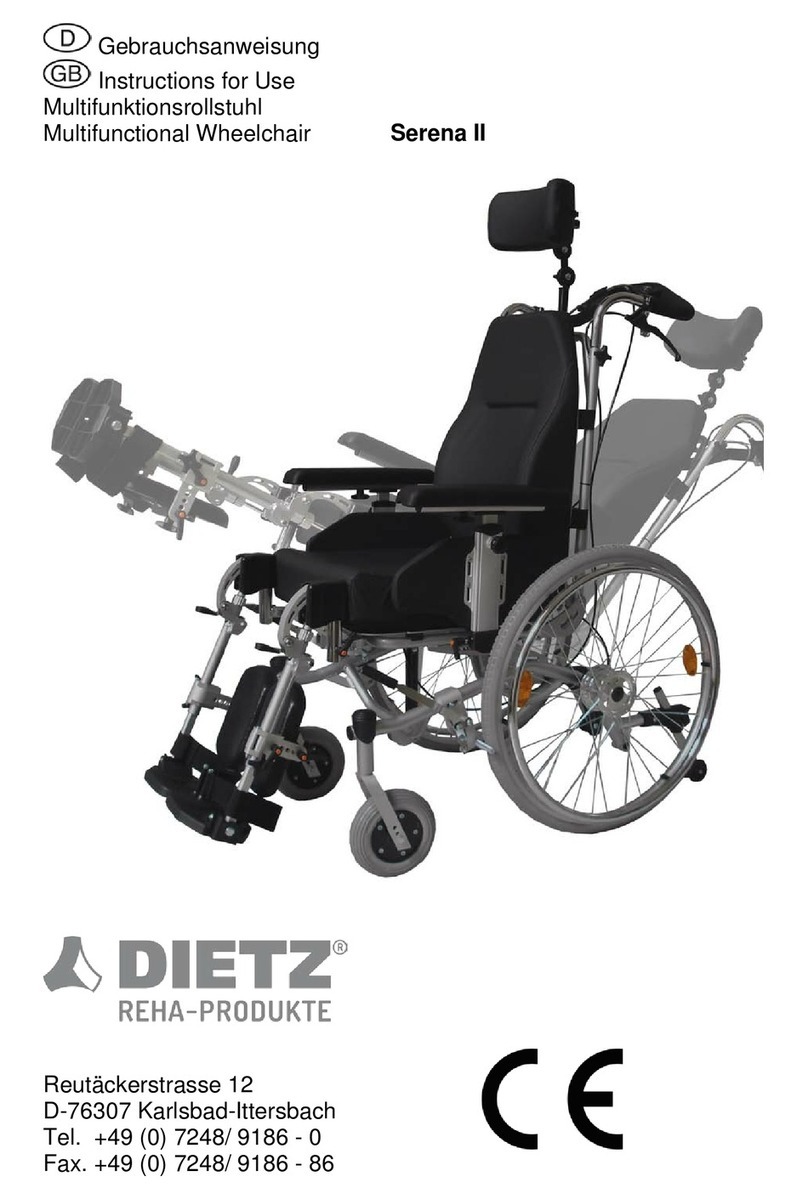
Dietz
Dietz Serena II User manual
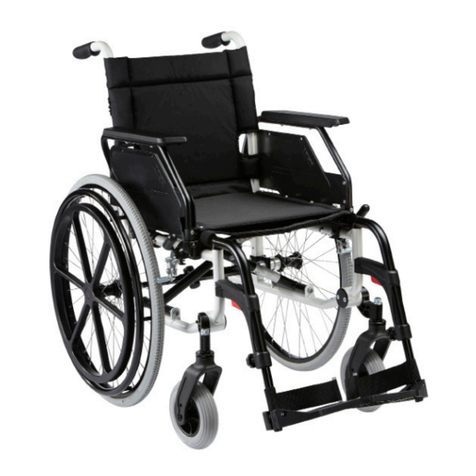
Dietz
Dietz 197022 User manual
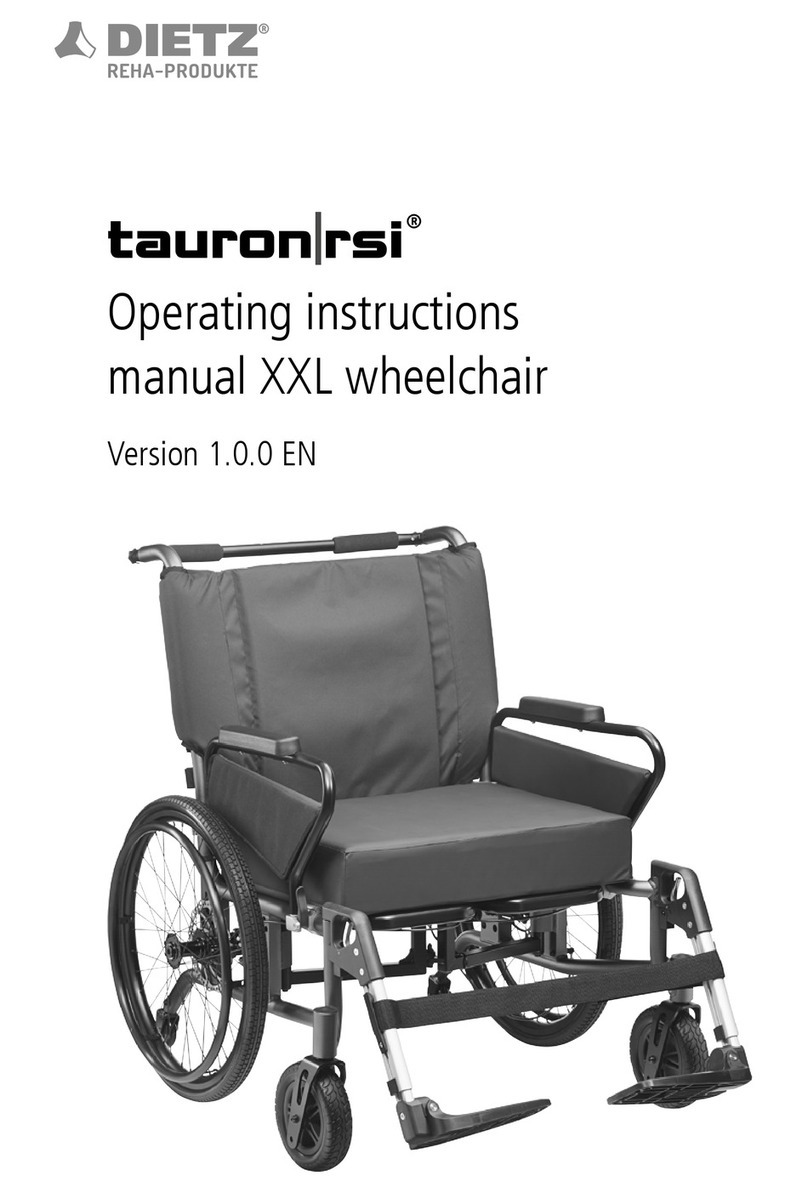
Dietz
Dietz tauron rsi XXL User manual
![Dietz AS[01] User manual Dietz AS[01] User manual](/data/manuals/1u/i/1ui1k/sources/dietz-as-01--manual.jpg)
Dietz
Dietz AS[01] User manual
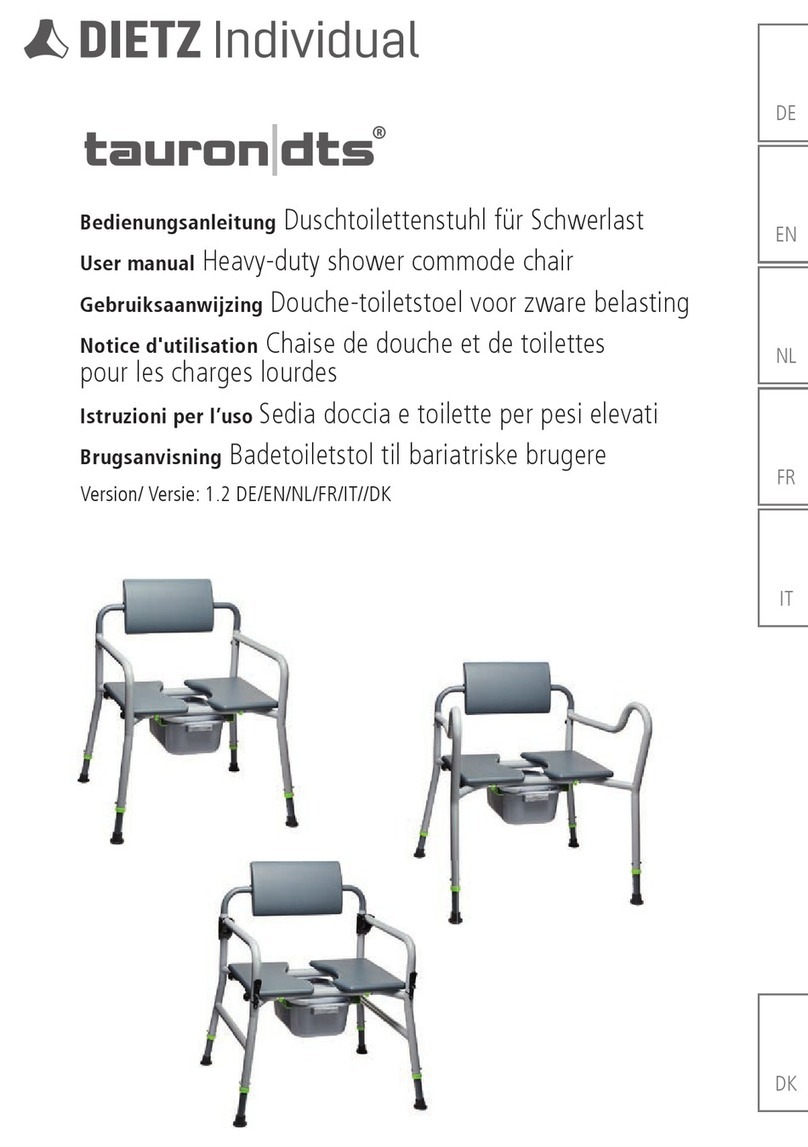
Dietz
Dietz Tauron User manual
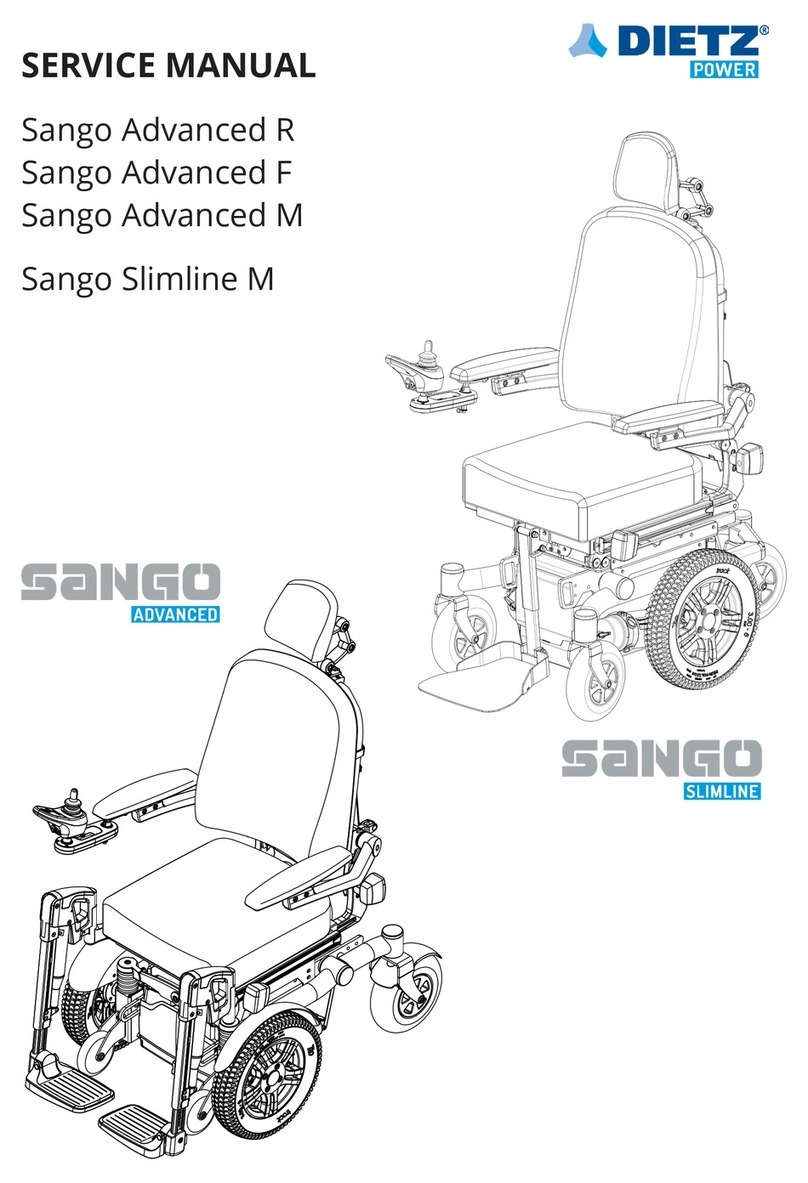
Dietz
Dietz SANGO ADVANCED Series User manual
